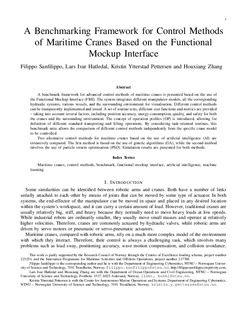A Benchmarking Framework for Control Methods of Maritime Cranes Based on the Functional Mockup Interface
Journal article
Submitted version
Permanent lenke
http://hdl.handle.net/11250/2471079Utgivelsesdato
2017Metadata
Vis full innførselSamlinger
Originalversjon
10.1109/JOE.2017.2691920Sammendrag
A benchmark framework for advanced control methods of maritime cranes is presented based on the use of the functional mockup interface. The system integrates different manipulator models, all the corresponding hydraulic systems, various vessels, and the surrounding environment for visualization. Different control methods can be transparently implemented and tested. A set of routine tests, different cost functions, and metrics are provided—taking into account several factors, including position accuracy, energy consumption, quality, and safety for both the cranes and the surrounding environment. The concept of operational profiles is introduced, allowing for definition of different standard transporting and lifting operations. By considering task-oriented routines, this benchmark suite allows the comparison of different control methods independently from the specific crane model to be controlled. Two alternative control methods for maritime cranes based on the use of artificial intelligence are extensively compared. The first method is based on the use of genetic algorithms, while the second method involves the use of particle swarm optimization. Simulation results are presented for both methods.
